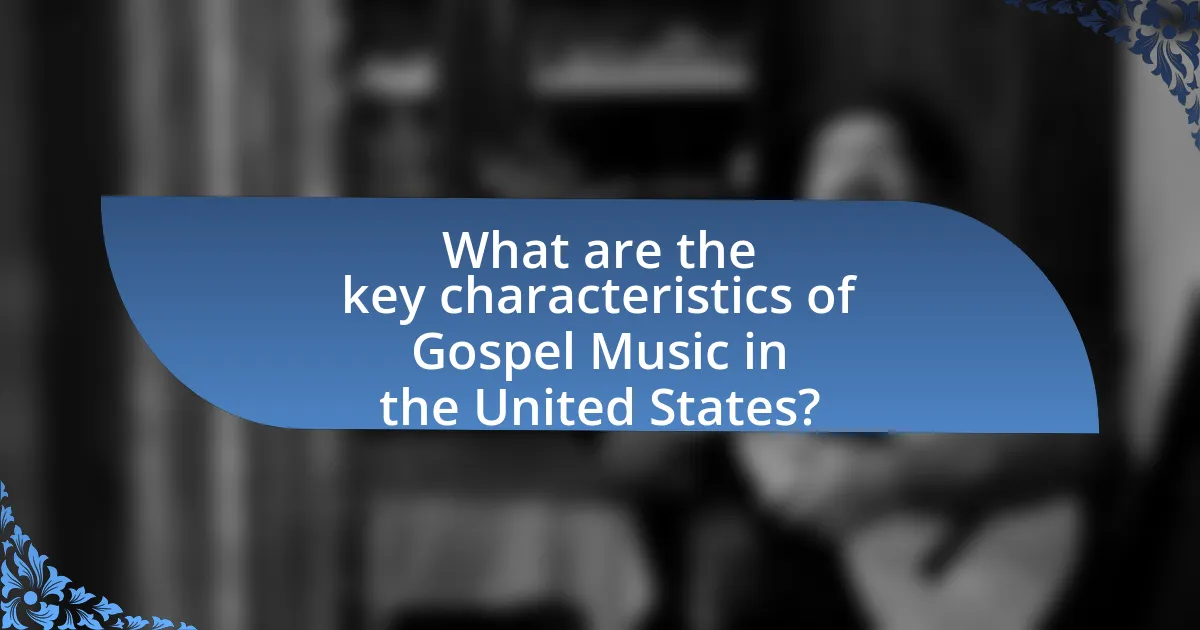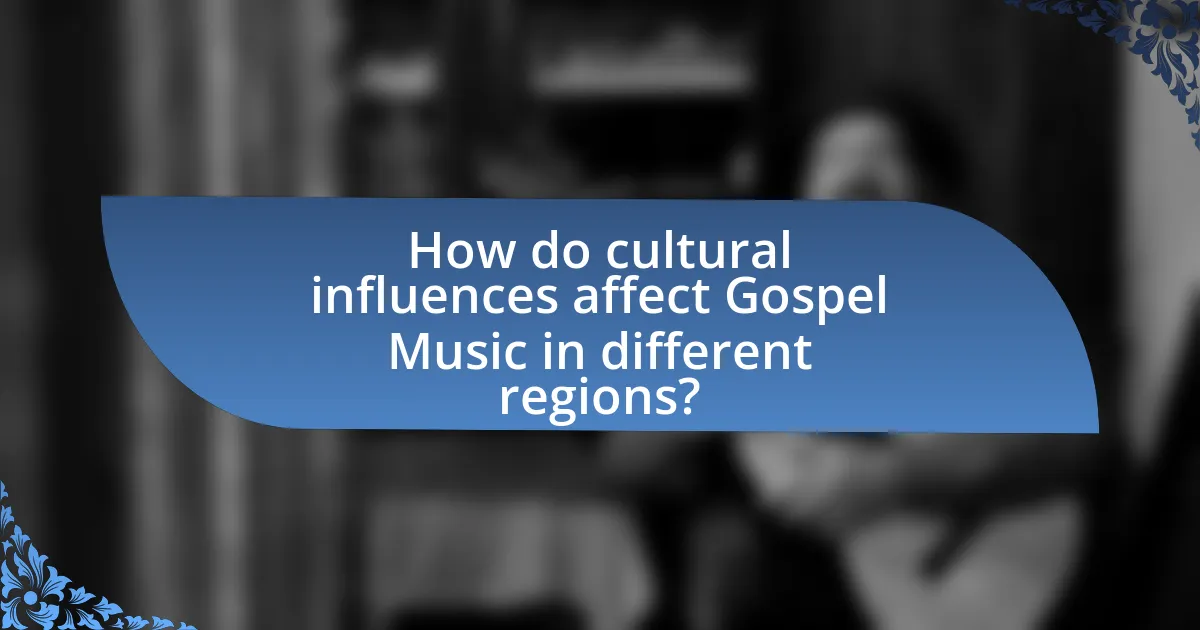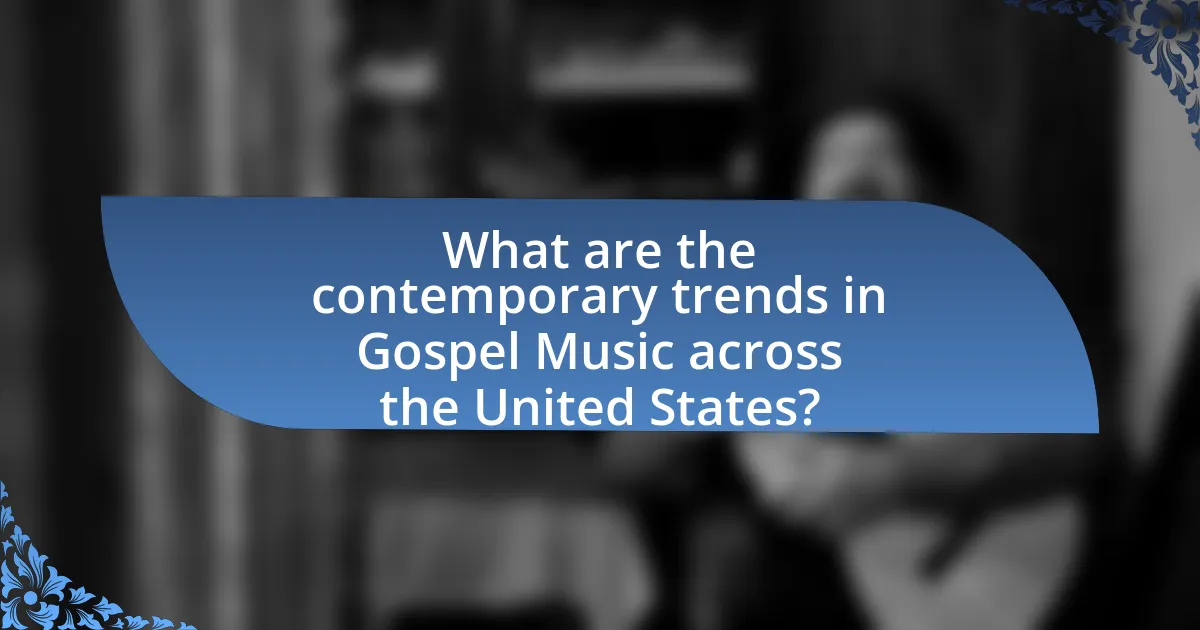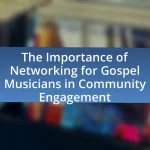Gospel music in the United States is a diverse genre characterized by spiritual themes, strong vocal emphasis, and communal participation, with roots in African American musical traditions. The article explores regional variations in gospel music, highlighting differences in style, instrumentation, and cultural influences across areas such as the Southern United States, the Midwest, and urban centers. It examines the historical factors that have shaped these variations, including the Great Migration and local church practices, while also addressing contemporary trends like the fusion of gospel with hip-hop and R&B. Additionally, the article discusses the impact of technology and social media on the production and consumption of gospel music, as well as the emerging genres within the field.

What are the key characteristics of Gospel Music in the United States?
Gospel music in the United States is characterized by its spiritual themes, strong vocal emphasis, and communal participation. This genre often incorporates elements of African American musical traditions, including call-and-response patterns, improvisation, and rhythmic intensity. Historically, gospel music emerged from the African American church experience in the late 19th century, evolving through various styles such as traditional, contemporary, and urban gospel. The use of instruments like the piano, organ, and drums is common, enhancing the emotional delivery of the lyrics, which typically focus on faith, hope, and redemption. The genre has also influenced and been influenced by other musical styles, including blues and jazz, reflecting its dynamic nature within American culture.
How does Gospel Music differ across various regions?
Gospel music differs across various regions primarily in style, instrumentation, and cultural influences. In the Southern United States, for example, gospel music often features a blend of African American spirituals and blues, characterized by rich vocal harmonies and the use of piano and organ. In contrast, the Midwest may incorporate elements of folk and country music, leading to a more acoustic sound with instruments like the guitar and banjo. The West Coast tends to embrace contemporary styles, integrating pop and rock influences, which can result in a more modern sound. These regional variations reflect the diverse cultural backgrounds and musical traditions present in each area, illustrating how gospel music evolves while maintaining its core spiritual message.
What are the defining features of Southern Gospel Music?
Southern Gospel Music is characterized by its rich vocal harmonies, strong emotional expression, and lyrics that focus on Christian themes. The genre typically features a quartet or group format, emphasizing harmony and often incorporating instruments like piano, guitar, and bass. Historically, Southern Gospel emerged in the early 20th century, influenced by the musical traditions of the Southern United States, including hymns and folk music. The genre is known for its upbeat tempos and the use of call-and-response patterns, which engage the audience. Additionally, Southern Gospel often includes elements of storytelling, conveying personal testimonies and spiritual journeys, which resonate deeply with listeners.
How does Contemporary Gospel Music reflect regional influences?
Contemporary Gospel Music reflects regional influences through its incorporation of local musical styles, cultural traditions, and community narratives. For instance, Southern Gospel often features elements of bluegrass and country music, reflecting the musical heritage of the Southern United States. In contrast, urban Contemporary Gospel incorporates hip-hop and R&B influences, mirroring the cultural dynamics of cities like Chicago and New York. This blending of genres not only showcases the diversity of American music but also highlights how regional experiences shape the themes and sounds of Gospel music, making it a unique expression of local identity and spirituality.
What historical factors have shaped regional variations in Gospel Music?
Historical factors that have shaped regional variations in Gospel Music include the Great Migration, the influence of local cultures, and the development of distinct musical styles. The Great Migration, which saw African Americans move from the rural South to urban areas in the North and West during the early to mid-20th century, led to the blending of Southern gospel traditions with urban musical forms like jazz and blues, resulting in unique regional styles such as Chicago gospel. Local cultures also played a significant role; for instance, the incorporation of Appalachian folk music elements in Southern gospel reflects the cultural heritage of the region. Additionally, the rise of different denominations and church practices across the United States has contributed to variations in lyrical themes and musical arrangements, as seen in the differences between Black church music in the South and contemporary gospel in urban areas. These historical factors collectively illustrate how regional variations in Gospel Music have evolved over time.
How did the Great Migration impact Gospel Music styles?
The Great Migration significantly transformed Gospel Music styles by introducing a blend of rural Southern traditions with urban Northern influences. As African Americans moved from the South to cities like Chicago and Detroit between 1916 and 1970, they brought their spirituals and hymns, which evolved into new forms such as Gospel and later, contemporary Christian music. This migration led to the incorporation of jazz, blues, and rhythm and blues elements into Gospel, creating a more dynamic and diverse sound. For instance, artists like Thomas A. Dorsey, who was pivotal in the development of Gospel music, fused traditional hymns with jazz rhythms, reflecting the cultural shifts of the time. The urban environment also facilitated the rise of Gospel choirs and the use of instruments, further diversifying the genre.
What role did local churches play in the development of regional Gospel Music?
Local churches were instrumental in the development of regional Gospel Music by serving as primary venues for worship and musical expression. These churches provided a communal space where congregations could gather to sing, pray, and share their faith, fostering a rich environment for the creation and performance of Gospel music. The integration of local cultural influences, such as folk traditions and musical styles, into church services led to the emergence of distinct regional sounds within Gospel music. For instance, the influence of African American spirituals in Southern churches contributed to the development of styles like shape note singing and the use of call-and-response techniques. This blending of religious practice and local musical heritage solidified the role of churches as vital hubs for the evolution and dissemination of Gospel music across various regions in the United States.

How do cultural influences affect Gospel Music in different regions?
Cultural influences significantly shape Gospel music across different regions by integrating local traditions, languages, and musical styles. For instance, in the Southern United States, Gospel music often incorporates elements of African American spirituals and blues, reflecting the historical context of the region. In contrast, Gospel music in the Caribbean may blend with reggae and calypso rhythms, showcasing the influence of local cultural practices and instruments. Furthermore, in urban areas, contemporary Gospel often merges with hip-hop and R&B, appealing to younger audiences and reflecting modern societal themes. These regional variations illustrate how cultural contexts inform the themes, instrumentation, and performance styles within Gospel music, making it a dynamic and evolving genre.
What are the unique cultural elements found in Gospel Music from the South?
Gospel music from the South is characterized by its deep roots in African American spirituals, communal worship, and improvisational styles. These cultural elements reflect the historical context of slavery and the quest for spiritual solace, which shaped the genre’s emotional depth and lyrical themes. The use of call-and-response patterns, a hallmark of African musical traditions, fosters community participation and engagement during performances. Additionally, Southern gospel music often incorporates elements of blues and folk, creating a unique sound that resonates with the experiences of Southern communities. The genre’s emphasis on storytelling and personal testimony further highlights the cultural significance of faith and resilience in the Southern experience.
How do African American traditions influence Southern Gospel Music?
African American traditions significantly influence Southern Gospel Music through their rich cultural heritage, musical styles, and spiritual expressions. The incorporation of call-and-response patterns, emotional vocal delivery, and rhythmic complexity in Southern Gospel can be traced back to African American musical practices, particularly those rooted in spirituals and blues. For instance, the use of improvisation and expressive phrasing in Southern Gospel reflects the influence of African American church music, which emphasizes personal connection and communal worship. Additionally, the themes of hope, struggle, and redemption prevalent in Southern Gospel lyrics often mirror the historical experiences of African Americans, further solidifying this cultural connection.
What impact do local dialects and languages have on Gospel lyrics?
Local dialects and languages significantly influence Gospel lyrics by shaping their linguistic style, cultural references, and emotional resonance. For instance, Gospel songs in Southern dialects often incorporate colloquial expressions and regional idioms, making the lyrics more relatable to local audiences. This connection enhances the communal experience of worship, as seen in the use of African American Vernacular English in many Gospel traditions, which reflects the cultural heritage and lived experiences of the community. Additionally, studies show that incorporating local languages can increase engagement and participation in worship settings, as congregants feel a deeper connection to the music that resonates with their identity and cultural background.
How does the audience’s demographics shape Gospel Music in various areas?
The audience’s demographics significantly shape Gospel Music by influencing its themes, styles, and performance practices across various regions. For instance, in predominantly African American communities, Gospel Music often incorporates elements of soul and rhythm and blues, reflecting cultural heritage and social experiences. In contrast, in more diverse or predominantly white areas, Gospel Music may lean towards contemporary Christian styles, emphasizing different lyrical content and musical arrangements.
Statistical data from the Pew Research Center indicates that 79% of Black Americans identify as Christian, which directly impacts the prevalence and style of Gospel Music in their communities. Additionally, regional variations can be observed in the instrumentation used; for example, Southern Gospel often features piano and quartets, while urban Gospel may include hip-hop influences. These demographic factors collectively shape the evolution and expression of Gospel Music, making it a dynamic reflection of the communities it serves.
What are the age and cultural backgrounds of Gospel Music listeners in the Midwest?
Gospel music listeners in the Midwest predominantly range from ages 30 to 65, with a significant portion being African American, reflecting the genre’s roots in Black church traditions. According to a 2020 study by the Pew Research Center, approximately 60% of Gospel music listeners identify as African American, while the remaining demographic includes Caucasian, Hispanic, and other cultural backgrounds, often influenced by local community churches and regional musical events. This demographic distribution highlights the cultural significance of Gospel music within African American communities in the Midwest, while also showcasing its growing appeal across diverse populations.
How do community events influence the popularity of Gospel Music in urban areas?
Community events significantly enhance the popularity of Gospel Music in urban areas by providing platforms for live performances and fostering community engagement. These events, such as festivals, church gatherings, and local concerts, create opportunities for artists to showcase their music directly to audiences, thereby increasing visibility and accessibility. For instance, the annual Gospel Music Workshop of America attracts thousands of participants and showcases various artists, which boosts local interest and participation in Gospel music. Additionally, community events often incorporate interactive elements, such as sing-alongs and workshops, which deepen audience connection to the genre. This engagement is supported by research indicating that live music experiences can increase genre appreciation and participation, as seen in studies conducted by the National Endowment for the Arts.

What are the contemporary trends in Gospel Music across the United States?
Contemporary trends in Gospel Music across the United States include the fusion of traditional gospel with contemporary genres such as hip-hop, R&B, and pop, leading to a broader appeal among younger audiences. This trend is evidenced by the rise of artists like Kirk Franklin and Tasha Cobbs Leonard, who incorporate modern sounds and production techniques into their music. Additionally, the use of digital platforms for distribution and promotion has increased, allowing for greater accessibility and engagement with diverse audiences. According to a 2021 report by the National Endowment for the Arts, gospel music’s influence has expanded significantly, with streaming services reporting a 30% increase in gospel music consumption over the past five years.
How is technology changing the way Gospel Music is produced and consumed?
Technology is significantly transforming the production and consumption of Gospel music by enabling easier access to recording tools and distribution platforms. Digital audio workstations (DAWs) allow artists to produce high-quality music from home studios, reducing the need for expensive studio time. Additionally, streaming services like Spotify and Apple Music provide global access to Gospel music, allowing artists to reach wider audiences without traditional distribution barriers. According to a 2021 report by the Recording Industry Association of America, streaming accounted for 83% of the music industry’s revenue, highlighting the shift in how music, including Gospel, is consumed today. This technological evolution not only democratizes music production but also enhances the visibility of diverse regional styles within Gospel music across the United States.
What role do social media platforms play in promoting regional Gospel artists?
Social media platforms play a crucial role in promoting regional Gospel artists by providing them with accessible channels to reach wider audiences. These platforms enable artists to share their music, engage with fans, and build a community around their work, which is essential for gaining visibility in a competitive music landscape. For instance, platforms like Facebook, Instagram, and YouTube allow artists to showcase their performances, share behind-the-scenes content, and interact directly with listeners, fostering a sense of connection and loyalty. Additionally, statistics indicate that 54% of social media users discover new music through these platforms, highlighting their effectiveness in expanding an artist’s reach and influence.
How has streaming affected the accessibility of regional Gospel Music styles?
Streaming has significantly increased the accessibility of regional Gospel music styles by allowing listeners to discover and enjoy diverse genres from various locations without geographical limitations. Platforms like Spotify, Apple Music, and YouTube have made it easier for artists to share their music globally, leading to a broader audience for regional styles such as Southern Gospel, Black Gospel, and Contemporary Christian music. According to a 2021 report by the Recording Industry Association of America, streaming accounted for 83% of the music industry’s revenue, highlighting its dominance and influence in music consumption. This shift has enabled niche genres, including regional Gospel styles, to reach listeners who may not have had access to them through traditional radio or local performances.
What are the emerging genres within Gospel Music today?
Emerging genres within Gospel Music today include contemporary Christian music, urban gospel, and gospel rap. Contemporary Christian music blends traditional gospel themes with modern pop and rock influences, appealing to a broader audience. Urban gospel incorporates elements of hip-hop and R&B, reflecting the cultural dynamics of urban communities. Gospel rap, a subgenre of urban gospel, features rap lyrics that convey spiritual messages, gaining popularity among younger listeners. These genres demonstrate the evolution of gospel music, adapting to contemporary musical trends while maintaining core spiritual themes.
How is Gospel Music blending with other musical genres in different regions?
Gospel music is blending with various musical genres across different regions by incorporating elements of local styles, resulting in unique fusions. For instance, in the Southern United States, gospel has merged with blues and country, creating a sound that reflects the cultural heritage of the area. In urban settings, such as Chicago and New York, gospel music has integrated with hip-hop and R&B, leading to the emergence of contemporary gospel that resonates with younger audiences. This blending is evidenced by artists like Kirk Franklin, who combines traditional gospel with modern beats, and the rise of gospel choirs that perform in diverse musical styles. The adaptability of gospel music to local influences demonstrates its dynamic nature and widespread appeal.
What are the characteristics of Gospel Rap and its regional variations?
Gospel Rap is characterized by its integration of Christian themes with hip-hop music elements, including rhythmic beats, spoken word, and lyrical storytelling that focuses on faith, redemption, and spiritual experiences. The genre often employs a variety of styles, from traditional gospel influences to contemporary urban sounds, reflecting the cultural backgrounds of its artists.
Regional variations of Gospel Rap can be observed across the United States. For instance, Southern Gospel Rap often incorporates elements of Southern hip-hop, blending traditional gospel melodies with trap beats, while artists from the Northeast may emphasize lyrical complexity and social commentary, drawing from the region’s rich hip-hop history. In contrast, West Coast Gospel Rap frequently features laid-back rhythms and smooth production, aligning with the broader West Coast hip-hop scene. These regional characteristics highlight the diverse expressions of faith within the genre, showcasing how local culture and musical influences shape the sound and message of Gospel Rap.
What practical tips can help listeners appreciate regional variations in Gospel Music?
Listeners can appreciate regional variations in Gospel Music by actively engaging with local artists and attending live performances. This direct exposure allows individuals to experience the unique cultural influences that shape the music in different areas, such as the Southern roots of traditional Gospel or the contemporary styles emerging in urban settings. Additionally, exploring the historical context of Gospel Music in various regions, such as the impact of the Civil Rights Movement in the South or the influence of African American church traditions, enhances understanding. Listening to a diverse range of recordings from different regions, including styles like Black Gospel, White Southern Gospel, and Contemporary Christian Music, further broadens appreciation. Engaging with community discussions or educational resources about the origins and evolution of Gospel Music in specific locales can also deepen listeners’ insights into its regional variations.


